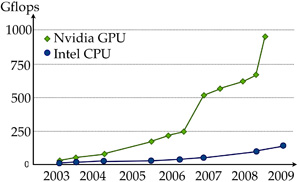Motivation
Scientific Computing on GPUs
The programmable GPU (graphics processing unit) is attracting a tremendous amount of attention, thanks to its exponentially faster progress compared to CPUs. Shown in the plot below is the computing capacity, in gigaflop/s, of subsequent generations of Intel CPUs and Nvidia GPUs. The peak performance of the latest GPU is several times greater than the latest CPU; more importantly, the trend is for the performance gap to get larger.

In fact, even more important than the raw performance is the extraordinarily better performance-per-watt. As high-performance computing centers are more and more burdened by high power costs, the energy efficiency of the GPU makes it a very attractive choice. And finally, the price/performance ratio makes the GPU architecture a real winner in many situations. Given that the market for GPUs was driven by the games industry, it is commodity hardware and significantly cheaper than any other alternative for high-performance computing.
Opportunity for the Americas
All of the above conditions make GPU computing a true and immediate opportunity for increasing scientific capacity in Latin American countries of the “scientifically developing” category. It is self-evident that different countries have different capacities to carry out scientific research and produce technological advances. In a report prepared for the World Bank by RAND [1], countries were systematically categorized into: scientifically advanced (22 countries), scientifically proficient (24 countries), scientifically developing (24 countries), and scientifically lagging (remaining 80 countries). No Latin American country falls in the first category, and only one (Brazil) is listed in the second. Argentina, Chile, Mexico, Colombia, Venezuela, Costa Rica and Bolivia are listed as scientifically developing countries. In the case of Argentina and Chile, the countries are quite close to moving to the “proficient” category, but are kept from being considered as such due to factors including the global national product (GNP) and general infrastructure. The analysis of the RAND report also clearly establishes that international collaboration is a powerful means of building scientific capacity.
The situation in several countries of Latin America is such, that they have a very strong human resource, with scientists trained in many of the best universities of the world, have strong ties of collaboration, but have reduced access to research infrastructure. The possibility of conducting advanced scientific research using GPUs means that research institutions in these countries can own and operate small computer clusters that can be used for cutting-edge, high-impact scientific discovery.
This PASI aims to initiate a pole of development for high-performance computing using modern hardware, and to stimulate international collaboration and future initiatives leading to student exchanges, joint projects and new funding opportunities for the participants.
References
[1] Wagner, C. S., I. Brahmakulam, B. Jackson, A. Wong, and T. Toda (2001) “Science and technology collaboration: Building capacity in developing countries, Tech. Rep. MR-1357.0-EB, RAND Science and Technology, Santa Monica, CA 90407 (prepared for the World Bank).